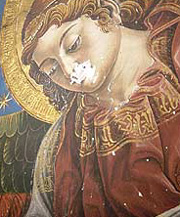 ARenaissancefrescohidden for 300 years has been rediscovered in Spain - thanks to nesting pigeons. ARenaissancefrescohidden for 300 years has been rediscovered in Spain - thanks to nesting pigeons.
Art restorers working in Valencia's cathedralspottedthe birds flying through a hole in what turned out to be a false ceiling and were intrigued. They stuck a digital camera in the gap and shot pictures that showed a well-preserved 15th century Italian fresco. It is one of the earliest and most important examples of such Renaissance art in Spain, experts say. The fresco, whichdepictsfour angels against a starry blue background, was painted by two Italians, Francesco Pagano and Paolo de San Leocadio, in the late 1400s. They were commissioned by apapalenvoy, Rodrigo Borja, a Spaniard who went on to become Pope Alexander VI in 1492. The fresco was covered up by aBaroqueceiling, believed to have been constructed around 1670, likely as a result of changing artistic tastes. Normally, baroque artists covering up an existing fresco wouldscrape it off,art historian Fernando Lopez told reporters. "This time they did not. They left anair pocket. That is the big surprise." The president of Valencia's government, Francisco Camps, said the find was "one of the most important cultural discoveries in recent years" in Spain. (Agencies)
| 在筑巢的鸽子的帮助下,一幅暗藏了300年的文艺复兴时期的油画在西班牙重见天日。 艺术修复者们在对西班牙巴伦西亚大教堂进行修复时,发现鸽子飞进飞出的洞口通往一个假屋顶,这引起了修复者的兴趣。 他们把数码相机搁在缺口上拍照,照片显示其中有一幅保存完好的15世纪的意大利壁画。 专家说,这是西班牙发现的最早也是最重要的此类文艺复兴时期的艺术品之一。 这幅壁画描绘的是在布满星星的蓝色背景下的四个天使,它是由两个意大利人弗朗西斯科·帕伽诺和保罗·圣·雷欧卡迪欧于15世纪末期完成的。 他们受命于罗马教皇特使罗德里格·波迦,这个西班牙人1492年成为了教皇亚历山大六世。 这幅壁画被巴洛克式的屋顶覆盖住了,这个屋顶据说建于1670年前后,很有可能是艺术风格转变的结果。 艺术史学家佛纳多·洛普兹告诉记者,一般来说巴洛克艺术家们掩盖已有的壁画时,会把壁画刮掉。 “这次他们没有刮掉壁画。还留下了气穴。太令人惊奇了。” 巴伦西亚市市长佛朗西斯科·坎普斯称该发现是西班牙“近年来最重要的文化发现之一”。 Renaissance:文艺复兴时期
fresco:壁画
spot:认出,发现
depict:描述,描写
papal:
罗马教皇的,教皇制度的
Baroque:巴洛克式的
air pocket:气穴
(中国日报网站译)
|
